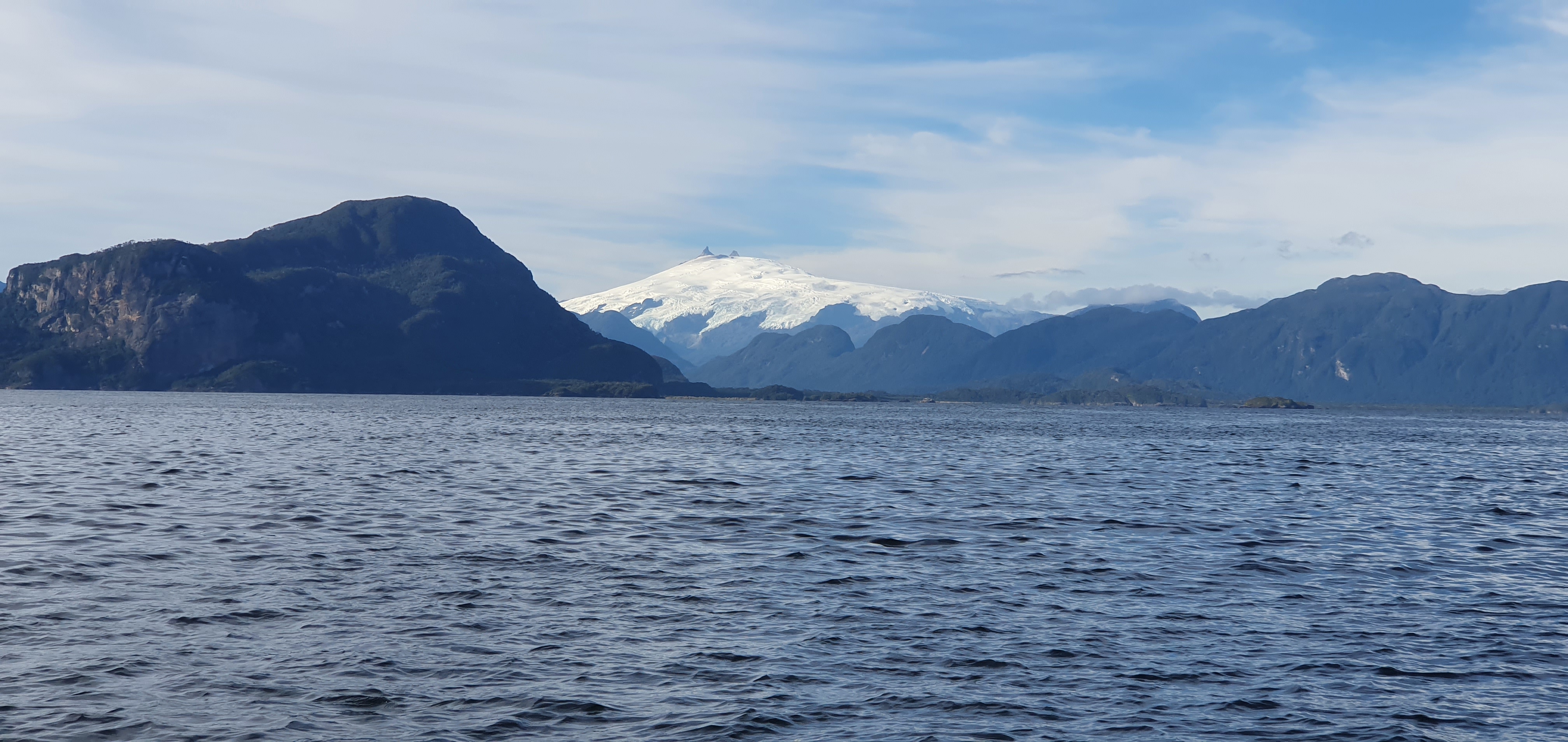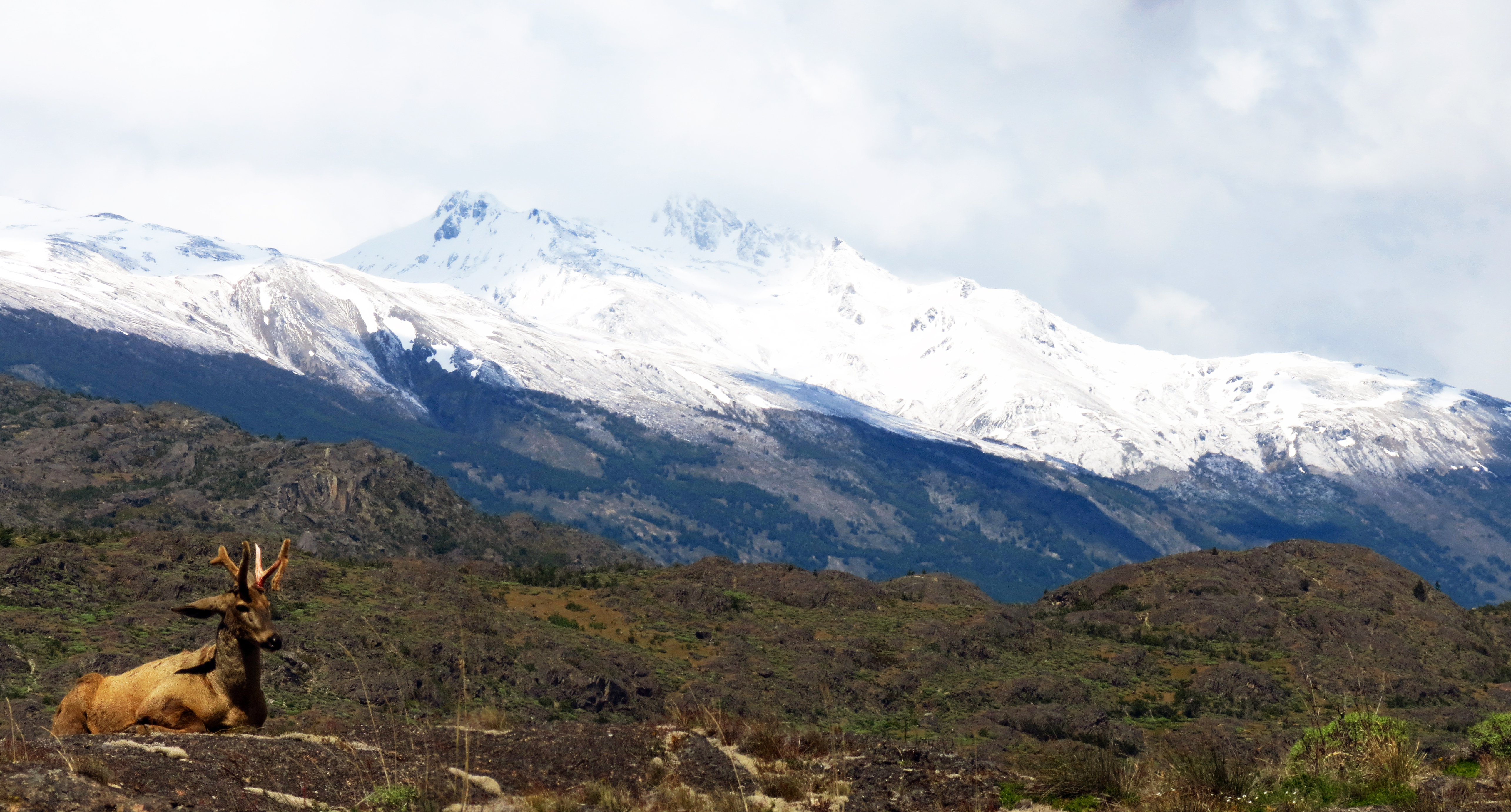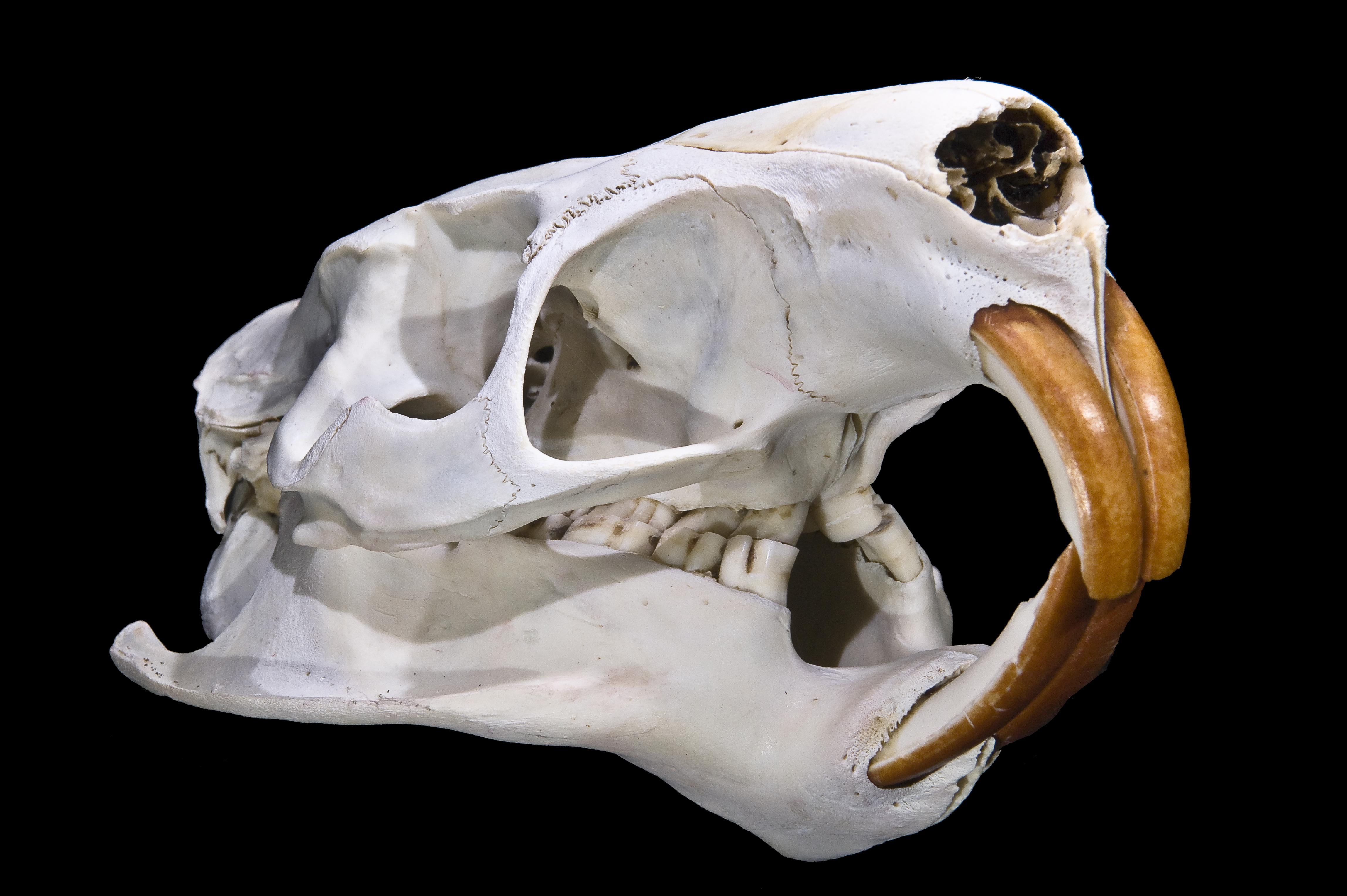|
Hornopirén National Park
Hornopirén National Park () is located in the Andes, in the Palena Province of Chile's Los Lagos Region, also known as Region X. The park contains of rugged mountains and unspoiled Valdivian temperate rain forests. This national park borders the northern portion of Pumalín Park. The Carretera Austral passes close to the park. In the vicinity of the park lie Hornopirén and Yate volcanoes. Geography The park is part of the Andes mountain chain. There are 22 hectares of mountains, glaciers and volcanoes. The park is dominated by glacier-carved mountains and active volcanoes. It includes glaciers comprising an area of . The Yate volcano stands 2,187 meters above sea level and the Hornopirén volcano stands 1,572 meters above sea level. From the Yate volcano southern slope, at only 1,500 meters, you can enjoy panoramic views of the mountains and forests of the park, including a full view of the lake and even Pinto Concha Hornopirén fjord. Water The three main bodies of water ... [...More Info...] [...Related Items...] OR: [Wikipedia] [Google] [Baidu] |
Los Lagos Region
Los Lagos Region ( es, Región de Los Lagos , ''Region of the Lakes'') is one of Chile's 16 regions, which are first order administrative divisions, and comprises four provinces: Chiloé, Llanquihue, Osorno and Palena. The region contains the country's second largest island, Chiloé, and the second largest lake, Llanquihue. Its capital is Puerto Montt; other important cities include Osorno, Castro, Ancud, and Puerto Varas. The mainland portion of Los Lagos Region south of Reloncaví Sound (Palena Province) is considered part of Patagonia. Historically, the Huilliche have called this territory between Bueno River and Reloncaví Sound Futahuillimapu, meaning "great land of the south". The region hosts Monte Verde, one of the oldest archaeological sites of the Americas. The largest indigenous group of the region are the Huilliche who lived in the area before the arrival of the Spanish. The Spanish crown settled Chiloé Archipelago in 1567 Hanisch, Walter. ''La Isla de Chi ... [...More Info...] [...Related Items...] OR: [Wikipedia] [Google] [Baidu] |
Kodkod
The kodkod (''Leopardus guigna'') (), also called guiña, is the smallest felid species native to the Americas. It lives primarily in central and southern Chile, as well as marginally in adjoining areas of Argentina. Since 2002, it has been listed as Vulnerable on the IUCN Red List as the total population may be less than 10,000 mature individuals; it is threatened by persecution, and loss of habitat and prey base. Characteristics The kodkod's fur color ranges from brownish-yellow to grey-brown. It has dark spots, a pale underside and a ringed tail. The ears are black with a white spot, while the dark spots on the shoulders and neck almost merge to form a series of dotted streaks. Melanistic kodkods with spotted black coats are quite common. It has a small head, large feet, and a thick tail. Adult kodkods are in head to body length with a short tail and a shoulder height of about . Weight ranges between . Melanistic phenotype The melanistic phenotype is caused by the deletion ... [...More Info...] [...Related Items...] OR: [Wikipedia] [Google] [Baidu] |
Protected Areas Established In 1988
Protection is any measure taken to guard a thing against damage caused by outside forces. Protection can be provided to physical objects, including organisms, to systems, and to intangible things like civil and political rights. Although the mechanisms for providing protection vary widely, the basic meaning of the term remains the same. This is illustrated by an explanation found in a manual on electrical wiring: Some kind of protection is a characteristic of all life, as living things have evolved at least some protective mechanisms to counter damaging environmental phenomena, such as ultraviolet light. Biological membranes such as bark on trees and skin on animals offer protection from various threats, with skin playing a key role in protecting organisms against pathogens and excessive water loss. Additional structures like scales and hair offer further protection from the elements and from predators, with some animals having features such as spines or camouflage servi ... [...More Info...] [...Related Items...] OR: [Wikipedia] [Google] [Baidu] |
Valdivian Temperate Forests
The Valdivian temperate forests (NT0404) is an ecoregion on the west coast of southern South America, in Chile and Argentina. It is part of the Neotropical realm. The forests are named after the city of Valdivia. The Valdivian temperate rainforests are characterized by their dense understories of bamboos, ferns, and for being mostly dominated by evergreen angiosperm trees with some deciduous specimens, though conifer trees are also common. Setting Temperate rain forests comprise a relatively narrow coastal strip between the Pacific Ocean to the west, and the southern Andes Mountains to the east, from roughly 37° to 48° south latitude. North of 42°, the Chilean coastal range runs along the coast, and the north–south running Chilean Central Valley lies between the coastal range and the Andes. South of 42°, the coast range continues as a chain of offshore islands, including Chiloé Island and the Chonos Archipelago, while the "Central Valley" is submerged and continues as the G ... [...More Info...] [...Related Items...] OR: [Wikipedia] [Google] [Baidu] |
Protected Areas Of Los Lagos Region
Protection is any measure taken to guard a thing against damage caused by outside forces. Protection can be provided to physical objects, including organisms, to systems, and to intangible things like civil and political rights. Although the mechanisms for providing protection vary widely, the basic meaning of the term remains the same. This is illustrated by an explanation found in a manual on electrical wiring: Some kind of protection is a characteristic of all life, as living things have evolved at least some protective mechanisms to counter damaging environmental phenomena, such as ultraviolet light. Biological membranes such as bark on trees and skin on animals offer protection from various threats, with skin playing a key role in protecting organisms against pathogens and excessive water loss. Additional structures like scales and hair offer further protection from the elements and from predators, with some animals having features such as spines or camouflage servin ... [...More Info...] [...Related Items...] OR: [Wikipedia] [Google] [Baidu] |
National Parks Of Chile
There are 42 national parks in Chile covering a total area of 13,206,810 hectares. retrieved 11 March 2022 Table See also * ; protected natural areas * National Monuments of Chile; structures and sites of cultural heritageReferences {{South America in topic, List of national parks of, countries_only=yes[...More Info...] [...Related Items...] OR: [Wikipedia] [Google] [Baidu] |
Lago Inexplorado
__NOTOC__ Lago, which means "lake" in Italian, Portuguese, Spanish and Galician, may refer to: Places *Lago, Calabria, a ''comune'' in the Province of Cosenza, Italy *Lago, Mexico, a municipality zone in the State of Mexico *Lago District, a ''distrito'' in Niassa Province, Mozambique * Lago, Portugal, a ''freguesia'' in the District of Braga *Lago, Asturias, a ''parroquia'' in the ''municipio'' of Allande, Spain *Lago, Texas, a census-designated place *Lagos, Nigeria, the largest city in Nigeria People *Anders Lago, Swedish politician *Ângela Lago (1945–2017), Brazilian children's writer and illustrator *Antonio Lago, Venice-born French motor vehicle manufacturer *Fábio Lago, Brazilian actor *Nais Lago, Italian actress *Virginia Lago (born 1946), Argentine actress Other uses *Lago (Madrid Metro), a station on Line 5 *Talbot-Lago, a type of car *''Lago'', a fictional western town depicted in the film, ''High Plains Drifter'' See also * Lagos (other) * del Lago (dis ... [...More Info...] [...Related Items...] OR: [Wikipedia] [Google] [Baidu] |
Puerto Montt
Puerto Montt (Mapuche: Meli Pulli) is a port city and commune in southern Chile, located at the northern end of the Reloncaví Sound in the Llanquihue Province, Los Lagos Region, 1,055 km to the south of the capital, Santiago. The commune spans an area of and has a population of 245,902 in 2017. It is bounded by the communes of Puerto Varas to the north, Cochamó to the east and southeast, Calbuco to the southwest and Maullín and Los Muermos to the west. Founded as late as 1853 during the German colonization of southern Chile, Puerto Montt soon outgrew older neighboring cities through its strategic position at the southern end of the Chilean Central Valley being a gateway city into the Chiloé Archipelago, the Llanquihue and Nahuel Huapi lakes and Western Patagonia. Puerto Montt has gained renown and grown significantly through the rise of Chile to become the second largest salmon producer of the world during the 1990s and 2000s. However, the Chilean salmon aquacult ... [...More Info...] [...Related Items...] OR: [Wikipedia] [Google] [Baidu] |
The National Forest Corporation
''The'' () is a grammatical article in English, denoting persons or things that are already or about to be mentioned, under discussion, implied or otherwise presumed familiar to listeners, readers, or speakers. It is the definite article in English. ''The'' is the most frequently used word in the English language; studies and analyses of texts have found it to account for seven percent of all printed English-language words. It is derived from gendered articles in Old English which combined in Middle English and now has a single form used with nouns of any gender. The word can be used with both singular and plural nouns, and with a noun that starts with any letter. This is different from many other languages, which have different forms of the definite article for different genders or numbers. Pronunciation In most dialects, "the" is pronounced as (with the voiced dental fricative followed by a schwa) when followed by a consonant sound, and as (homophone of the archaic pron ... [...More Info...] [...Related Items...] OR: [Wikipedia] [Google] [Baidu] |
Chilean Huemul
The south Andean deer (''Hippocamelus bisulcus''), also known as the southern guemal, south Andean huemul, southern huemul, or Chilean ''huemul'' or '' güemul'' ( , ), is an endangered species of deer native to the mountains of Argentina and Chile. Along with the northern guemal or taruca, it is one of the two mid-sized deer in the ''Hippocamelus'' genus and ranges across the high mountainsides and cold valleys of the Andes. The distribution and habitat, behaviour, and diet of the deer have all been the subject of study. The viability of the small remaining population is an outstanding concern to researchers. The huemul is part of Chile's national coat of arms and is since 2006 a National Natural Monument. Description The south Andean deer is well-adapted to broken, difficult terrain with a stocky build and short legs. A brown to greyish-brown coat tapers to white undersides and a white marked throat; the long, curled hairs of the coat provide protection against cold and moi ... [...More Info...] [...Related Items...] OR: [Wikipedia] [Google] [Baidu] |
Pudú
The pudus (Mapudungun ''püdü'' or ''püdu'', es, pudú, ) are two species of South American deer from the genus ''Pudu'', and are the world's smallest deer. The chevrotains (mouse-deer; Tragulidae) are smaller, but they are not true deer. The name is a loanword from Mapudungun, the language of the indigenous Mapuche people of central Chile and south-western Argentina. The two species of pudus are the northern pudu (''Pudu mephistophiles'') from Venezuela, Colombia, Ecuador, and Peru, and the southern pudu (''Pudu puda''; sometimes incorrectly modified to ''Pudu pudu'') from southern Chile and south-western Argentina. Pudus range in size from tall, and up to long. The southern pudu is classified as near threatened, while the northern pudu is classified as Data Deficient in the IUCN Red List. Taxonomy The genus ''Pudu'' was first erected by English naturalist John Edward Gray in 1850. ''Pudua'' was a Latinized version of the name proposed by Alfred Henry Garrod in 1877, but wa ... [...More Info...] [...Related Items...] OR: [Wikipedia] [Google] [Baidu] |
Coypu
The nutria (''Myocastor coypus''), also known as the coypu, is a large, herbivorous, semiaquatic rodent. Classified for a long time as the only member of the family Myocastoridae, ''Myocastor'' is now included within Echimyidae, the family of the spiny rats. The nutria lives in burrows alongside stretches of water, and feeds on river plant stems. Originally native to subtropical and temperate South America, it has since been introduced to North America, Europe, Asia, and Africa, primarily by fur farmers. Although it is still hunted and trapped for its fur in some regions, its destructive burrowing and feeding habits often bring it into conflict with humans, and it is considered an invasive species. Nutria also transmit various diseases to humans and animals mainly through water contamination. Etymology The genus name ''Myocastor'' derives from the two Ancient Greek words (), meaning "rat, mouse", and (), meaning "beaver". Literally, therefore, the name ''Myocastor'' means ... [...More Info...] [...Related Items...] OR: [Wikipedia] [Google] [Baidu] |




.png)

